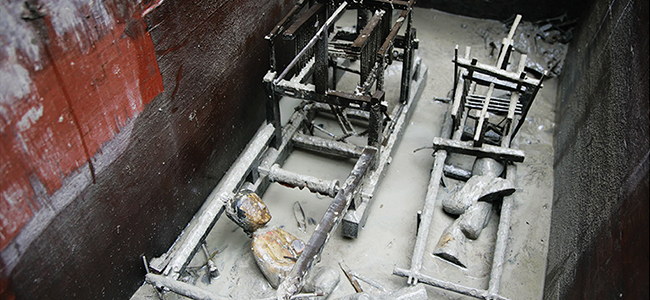‘Belt and Road’ drives humanities research

In April, British journal Antiquity published a cover photo to introduce the model looms discovered in the Han Dynasty chambered tomb in Chengdu, southwest China, which is the earliest known evidence of pattern loom technology. The “Belt and Road” initiative has promoted studies in humanities, and research results of Chinese scholars have been attracting increasing international attention.
Recently, scholars called for more cultural and humanities research to supplement studies on the economic and political aspects of the “Belt and Road” initiative and provide a theoretical basis for cultural construction.
Since it was proposed in 2013, the initiative has brought new opportunities to the field of humanities. Studies of literature, history, archaeology and religion have borne fruits as increasing numbers of Chinese scholars go abroad to conduct research in nations along the routes of the “Belt and Road.”
Research results of Chinese scholars have greatly promoted academic, cultural exchanges and cooperation, and are attracting increasing attention from international peers.
In 2014, British journal Antiquity published “The Hepu Han tombs and the Maritime Silk Road of the Han Dynasty” written by Xiong Zhaoming, a research fellow from the Guangxi Institute for Cultural Heritage Preservation and Archaeological Research. In 2017, the journal introduced in the cover story “The Earliest Evidence of Pattern Looms: Han Dynasty Tomb Models from Chengdu, China” co-authored by Zhao Feng, curator of China National Silk Museum.
Archaeologists from the Institute of Archaeology at the Chinese Academy of Social Sciences (CASS) and the Archaeology Institute of the Uzbekistan Academy of Sciences have together made significant discoveries at the Mingtepa ruins, shedding light on research of the Fergana Valley and ancient Central Asia.
Through many years of investigation and excavation in Uzbekistan, an archaeological team led by Wang Jianxin, a professor from Northwest University in Xi’an, offered different opinions on the theory that the Greater Yuezhi established the Kushan Empire.
For many years, the Chinese Academy of Cultural Heritage has been authorized by the Chinese government to provide assistance for the protection and restoration of the ruins of Angkor in Cambodia. It collaborated with the Cambodian side to finish an archaeological report on Ta Keo Temple in Angkor. In 2016, it cooperated with the School of Sociology and Anthropology at Sun Yat-sen University on a major project to study archaeology of the Angkor ruins and ancient China-Cambodia cultural exchanges.
Though it has made a number of achievements, Chinese academia faces challenges as it attempts to properly understand partner countries along the routes, said Li Xiao, a professor of Guoxue, or “Chinese classics,” from Renmin University of China, citing an example that many scholars cannot read first-hand materials and have to resort to Chinese documents when studying the histories of some Central Asian countries. Also, many scholars warned of empty, superficial and labeling studies.
It is significant to probe into the development experience of the ancient Silk Road for reference to the construction of the “Belt and Road,” said Li Guoqiang, deputy director of the Institute of Chinese Borderland Studies at CASS. He said, theoretical and practical research should be strengthened in humanities, which will drive the development of innovative platforms and channels for China to be better integrated with other countries.
ZHANG CHUNHAI is a reporter at the Chinese Social Sciences Today.
